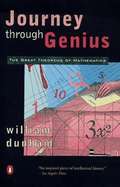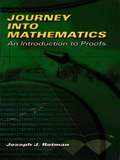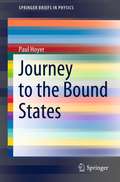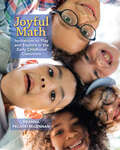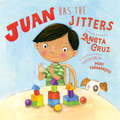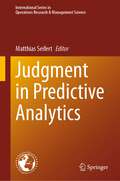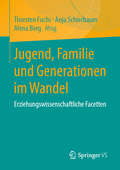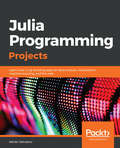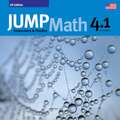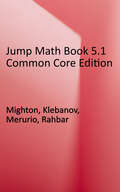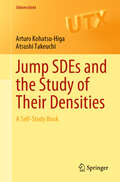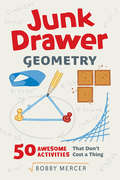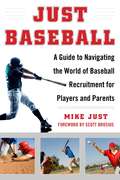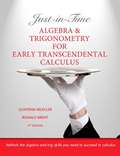- Table View
- List View
Journey Through Genius: The Great Theorems Of Mathematics
by William DunhamLike masterpieces of art, music, and literature, great mathematical theorems are creative milestones, works of genius destined to last forever. Now William Dunham gives them the attention they deserve. Dunham places each theorem within its historical context and explores the very human and often turbulent life of the creator -- from Archimedes, the absentminded theoretician whose absorption in his work often precluded eating or bathing, to Gerolamo Cardano, the sixteenth-century mathematician whose accomplishments flourished despite a bizarre array of misadventures, to the paranoid genius of modern times, Georg Cantor. He also provides step-by-step proofs for the theorems, each easily accessible to readers with no more than a knowledge of high school mathematics. A rare combination of the historical, biographical, and mathematical, Journey Through Genius is a fascinating introduction to a neglected field of human creativity.
Journey into Mathematics: An Introduction to Proofs (Dover Books on Mathematics)
by Joseph J. RotmanStudents learn how to read and write proofs by actually reading and writing them, asserts author Joseph J. Rotman, adding that merely reading about mathematics is no substitute for doing mathematics. In addition to teaching how to interpret and construct proofs, Professor Rotman's introductory text imparts other valuable mathematical tools and illustrates the intrinsic beauty and interest of mathematics.Journey into Mathematics offers a coherent story, with intriguing historical and etymological asides. The three-part treatment begins with the mechanics of writing proofs, including some very elementary mathematics--induction, binomial coefficients, and polygonal areas--that allow students to focus on the proofs without the distraction of absorbing unfamiliar ideas at the same time. Once they have acquired some geometric experience with the simpler classical notion of limit, they proceed to considerations of the area and circumference of circles. The text concludes with examinations of complex numbers and their application, via De Moivre's theorem, to real numbers.
Journey to the Bound States (SpringerBriefs in Physics)
by Paul HoyerThis book is a graduate-level self-study guide of bound states in elementary particle physics and consequently in the standard model. The author first recalls the usual quantum electrodynamics (QED) approach to atoms in terms of Feynman diagrams, which assume free states at asymptotic times. Motivated by general principles and data, he then develops a novel method based on a Fock expansion of bound states in temporal gauge. The properties of relativistic bound states are discussed for Dirac states, atoms in motion, QED in D=1+1 dimensions, and hadrons in quantum chromodynamics (including color confinement). This book provides complementary material for quantum field theory courses and is accessible for graduate students and more senior researchers.
Journey to the Edge of Reason: The Life Of Kurt Gödel
by Stephen BudianskyThe first major biography of the logician and mathematician whose Incompleteness Theorems helped launch a modern scientific revolution. Nearly a hundred years after its publication, Kurt Gödel’s famous proof that every mathematical system must contain propositions that are true—yet never provable—continues to unsettle mathematics, philosophy, and computer science. Yet unlike Einstein, with whom he formed a warm and abiding friendship, Gödel has long escaped all but the most casual scrutiny of his life. Stephen Budiansky’s Journey to the Edge of Reason is the first biography to fully draw upon Gödel’s voluminous letters and writings—including a never-before-transcribed shorthand diary of his most intimate thoughts—to explore Gödel’s profound intellectual friendships, his moving relationship with his mother, his troubled yet devoted marriage, and the debilitating bouts of paranoia that ultimately took his life. It also offers an intimate portrait of the scientific and intellectual circles in prewar Vienna, a haunting account of Gödel’s and Jewish intellectuals’ flight from Austria and Germany at the start of the Second World War, and a vivid re-creation of the early days of Princeton’s Institute for Advanced Study, where Gödel and Einstein both worked. Eloquent and insightful, Journey to the Edge of Reason is a fully realized portrait of the odd, brilliant, and tormented man who has been called the greatest logician since Aristotle, and illuminates the far-reaching implications of Gödel’s revolutionary ideas for philosophy, mathematics, artificial intelligence, and man’s place in the cosmos.
Journeys to Data Mining
by Mohamed Medhat GaberData mining, an interdisciplinary field combining methods from artificial intelligence, machine learning, statistics and database systems, has grown tremendously over the last 20 years and produced core results for applications like business intelligence, spatio-temporal data analysis, bioinformatics, and stream data processing. The fifteen contributors to this volume are successful and well-known data mining scientists and professionals. Although by no means an exhaustive list, all of them have helped the field to gain the reputation and importance it enjoys today, through the many valuable contributions they have made. Mohamed Medhat Gaber has asked them (and many others) to write down their journeys through the data mining field, trying to answer the following questions: 1. What are your motives for conducting research in the data mining field? 2. Describe the milestones of your research in this field. 3. What are your notable success stories? 4. How did you learn from your failures? 5. Have you encountered unexpected results? 6. What are the current research issues and challenges in your area? 7. Describe your research tools and techniques. 8. How would you advise a young researcher to make an impact? 9. What do you predict for the next two years in your area? 10. What are your expectations in the long term? In order to maintain the informal character of their contributions, they were given complete freedom as to how to organize their answers. This narrative presentation style provides PhD students and novices who are eager to find their way to successful research in data mining with valuable insights into career planning. In addition, everyone else interested in the history of computer science may be surprised about the stunning successes and possible failures computer science careers (still) have to offer.
Joy of Mathematics: Marvels, Novelties, and Neglected Gems That Are Rarely Taught in Math Class
by Alfred S. Posamentier Robert GeretschlagerWouldn't it be great if all school teachers (from kindergarten through high school) would share the joy of mathematics with their students, rather than focus only on the prescribed curriculum that will subsequently be tested? This book reveals some of the wonders of mathematics that are often missing from classrooms. Here's your chance to catch up with the math gems you may have missed. Using jargon-free language and many illustrations, the authors—all veteran math educators—explore five areas—arithmetic, algebra, geometry, probability, and the ways in which mathematics can reinforce common sense. Among other things, you'll learn "the rule of 72," which enables you to quickly determine how long it will take your bank account to double its value at a specific interest rate. Other handy techniques include an automatic algorithm for multiplying numbers mentally and a clever application that will allow you to convert from miles to kilometers (or the reverse) mentally. A delightful presentation of geometric novelties reveals relationships that could have made your study of geometry more fun and enlightening. In the area of probability there is a host of interesting examples: from the famous Monty-Hall problem to the counterintuitive probability of two people having the same birthday in a crowded room. Finally, the authors demonstrate how math will make you a better thinker by improving your organizing abilities and providing useful and surprising solutions to common mathematics problems. You'll come away with an appreciation for math you never thought possible and a true appreciation for this "queen of the sciences."
Joyful Math: Invitations to Play and Explore in the Early Childhood Classroom
by Deanna Pecaski McLennanIf you've ever wished that learning math could be more joyful and playful for young learners, you're not alone. In Joyful Math: Invitations to Play and Explore in the Early Childhood Classroom, kindergarten teacher Deanna Pecaski McLennan opens her classroom doors to share the practical, yet innovative ways she integrates mathematical play throughout the school day. Each chapter of this easy-to-navigate, photo-filled book focuses on specific strategies, activities and examples of mathematical play within literacy, art, and outdoor explorations. Inside Joyful Mathyou'll find: A photo guide, including suggested tools and materials, to setting up a classroom environment and space that fosters mathematical curiosity and joyDozens of open-ended and teacher-guided mathematical activities that are simple to set up and full of mathematical possibilityPractical tips for including mathematical play across the daySuggestions and examples of ways to document and share children's learning experiences with families and communitiesJoyful Math will inspire educators to make space for joy and play in early childhood mathematics and give them the tools to make this vision a reality.
Joyful Mathematics class 1 - NCERT - 23
by National Council of Educational Research and TrainingThe book "Joyful Mathematics" for Class 1 is designed as an engaging and interactive introduction to foundational mathematical concepts for young learners, aligned with the National Education Policy 2020. The textbook emphasizes a play-based approach, integrating activities, games, and real-life contexts to make learning mathematics enjoyable and relevant. Each chapter focuses on building fundamental skills such as number recognition, counting, basic operations, and spatial understanding through hands-on activities and interactive discussions. The book also encourages the development of critical thinking, problem-solving, and environmental awareness, while promoting inclusivity and cultural rootedness. With a variety of illustrations, stories, and puzzles, the textbook aims to make mathematics a joyful and meaningful experience for children in their early years.
Joyful Mathematics class 2 - NCERT - 23
by National Council of Educational Research and TrainingIn the second grade NCERT math curriculum, students delve deeper into foundational mathematical concepts, building upon what they learned in the first grade. This level emphasizes developing a strong understanding of numbers, basic operations, and geometric shapes through interactive and engaging activities. A key focus of the curriculum is on strengthening the children's grasp of addition and subtraction. They learn to add and subtract numbers within 100 using various strategies such as counting on, making groups, and using number lines. Through practical exercises and real-life examples, students develop fluency in these fundamental operations, setting a solid mathematical foundation for future learning.
Juan Has the Jitters
by Aneta CruzA story about inclusion, diversity, and the power of math to help one boy with autism thrive among his peers.Juan claps his hands to get his Jitters out. They make his tummy swoosh and swirl. His Jitters happen when there are too many people, too much noise, or too many changes to his day. Juan doesn't like surprises.Tomorrow there is an athletic event planned at school, which makes Juan very nervous. But his teacher has the perfect solution: math--Juan's favorite subject! Counting, sorting, and matching help Juan calm his Jitters. By making math part of the day's athletic games, and by appointing Juan the official judge, his teacher can make sure that Juan will have fun and feel included. The class is calling it the Mathletic Games! Parents of children 4 to 8 years-old can use this book to help teach kids about neurodiversity, inclusion, and the beauty in what makes every one of us unique. Teachers will find the book meets several Common Core Standards for pre-K through third grade in reading and math, and nurtures multiple domains of scholastic development.
Judgment in Predictive Analytics (International Series in Operations Research & Management Science #343)
by Matthias SeifertThis book highlights research on the behavioral biases affecting judgmental accuracy in judgmental forecasting and showcases the state-of-the-art in judgment-based predictive analytics. In recent years, technological advancements have made it possible to use predictive analytics to exploit highly complex (big) data resources. Consequently, modern forecasting methodologies are based on sophisticated algorithms from the domain of machine learning and deep learning. However, research shows that in the majority of industry contexts, human judgment remains an indispensable component of the managerial forecasting process. This book discusses ways in which decision-makers can address human behavioral issues in judgmental forecasting. The book begins by introducing readers to the notion of human-machine interactions. This includes a look at the necessity of managerial judgment in situations where organizations commonly have algorithmic decision support models at their disposal. The remainder of the book is divided into three parts, with Part I focusing on the role of individual-level judgment in the design and utilization of algorithmic models. The respective chapters cover individual-level biases such as algorithm aversion, model selection criteria, model-judgment aggregation issues and implications for behavioral change. In turn, Part II addresses the role of collective judgments in predictive analytics. The chapters focus on issues related to talent spotting, performance-weighted aggregation, and the wisdom of timely crowds. Part III concludes the book by shedding light on the importance of contextual factors as critical determinants of forecasting performance. Its chapters discuss the usefulness of scenario analysis, the role of external factors in time series forecasting and introduce the idea of mindful organizing as an approach to creating more sustainable forecasting practices in organizations.
Jugend, Familie und Generationen im Wandel: Erziehungswissenschaftliche Facetten
by Alena Berg Thorsten Fuchs Anja SchierbaumJugend, Familie und Generationen sind durch einen fortschreitenden sozialen Wandel in allen Lebensbereichen charakterisiert. Eine Gesamtgestalt der vielgestaltigen Entwicklungen herauszuarbeiten, scheint kaum noch möglich. Im Zentrum des vorliegenden Bands steht daher die Erarbeitung von erziehungswissenschaftlichen Facetten. Die beteiligten Autorinnen und Autoren nehmen sich mit theoretisch-konzeptionellen Überlegungen und aktuellen Forschungsprojekten den Veränderungen (spät-)moderner Jugendwelten mitsamt den hierdurch hervortretenden wissenschaftlichen Herausforderungen an, diskutieren unterschiedliche Teilaspekte der Jugendforschung, reflektieren Konturen der Familienerziehung und setzen Stichworte um Generationenbeziehungen und -verhältnisse auf die Agenda. Die zusammengetragenen Befunde gleichen dabei dem Sehen mit einem Facettenauge, das – bestehend aus zahlreichen einzelnen Linsen – bei gleichbleibender Größe ein erstaunliches Gesamtbild zum Wandel von Jugend, Familie und Generationen liefert.
Julia Programming Projects: Learn Julia 1.x by building apps for data analysis, visualization, machine learning, and the web
by Adrian SalceanuA step-by-step guide that demonstrates how to build simple-to-advanced applications through examples in Julia Lang 1.x using modern tools Key Features Work with powerful open-source libraries for data wrangling, analysis, and visualization Develop full-featured, full-stack web applications Learn to perform supervised and unsupervised machine learning and time series analysis with Julia Book Description Julia is a new programming language that offers a unique combination of performance and productivity. Its powerful features, friendly syntax, and speed are attracting a growing number of adopters from Python, R, and Matlab, effectively raising the bar for modern general and scientific computing. After six years in the making, Julia has reached version 1.0. Now is the perfect time to learn it, due to its large-scale adoption across a wide range of domains, including fintech, biotech, education, and AI. Beginning with an introduction to the language, Julia Programming Projects goes on to illustrate how to analyze the Iris dataset using DataFrames. You will explore functions and the type system, methods, and multiple dispatch while building a web scraper and a web app. Next, you'll delve into machine learning, where you'll build a books recommender system. You will also see how to apply unsupervised machine learning to perform clustering on the San Francisco business database. After metaprogramming, the final chapters will discuss dates and time, time series analysis, visualization, and forecasting. We'll close with package development, documenting, testing and benchmarking. By the end of the book, you will have gained the practical knowledge to build real-world applications in Julia. What you will learn Leverage Julia's strengths, its top packages, and main IDE options Analyze and manipulate datasets using Julia and DataFrames Write complex code while building real-life Julia applications Develop and run a web app using Julia and the HTTP package Build a recommender system using supervised machine learning Perform exploratory data analysis Apply unsupervised machine learning algorithms Perform time series data analysis, visualization, and forecasting Who this book is for Data scientists, statisticians, business analysts, and developers who are interested in learning how to use Julia to crunch numbers, analyze data and build apps will find this book useful. A basic knowledge of programming is assumed.
Julia Programming for Physics Applications
by R. Gökhan Türeci Hamdi Dağıstanlı İlkay Türk ÇakırNavigating the realm where physics intersects with programming, this book serves as an indispensable guide for students embarking on their journey with Julia. Whether it is plotting equations or analyzing experimental data, mastering computational tools is essential for unraveling the complexities of physical phenomena. Julia, an open-source programming language, emerges as the bridge between simplicity and efficiency. While Python, another open-source language, offers user-friendly syntax, its line-by-line execution often leads to sluggish performance. Julia, however, embodies the ethos of being "as easy as Python but as fast as C/C++," tailored specifically for scientific computing with ongoing developmental enhancements. Notably, Microsoft's AI assistant Copilot is crafted in Julia, showcasing its versatility and adaptability. Within these pages, readers encounter cutting-edge research illustrating Julia's prowess across diverse domains. From streamlined code composition facilitated by modular architecture to the integration of artificial intelligence and graphical visualization, this book illuminates Julia's multifaceted applications. It notably avoids delving into AI algorithms, instead focusing on equipping readers with foundational Julia skills applicable to physics problem-solving. Julia boasts an extensive library ecosystem tailored for scientific computing, empowering users with tools for tasks ranging from differential equation solving to statistical analysis. Its robust support for parallel processing enables swift computations on multi-core systems, a crucial asset for handling voluminous datasets with finesse. Starting with a primer on Julia fundamentals, the book gradually transitions to practical applications across various physics subdomains. From nuclear physics to high-energy phenomena, each chapter offers hands-on exercises that cement comprehension and foster proficiency in employing computational methods to unravel complex physical phenomena. Designed as a precursor to deeper explorations into AI applications within scientific realms, this book lays the groundwork for harnessing Julia's capabilities in physics-centric contexts.
Julia Quick Syntax Reference: A Pocket Guide for Data Science Programming
by Antonello LobiancoLearn the Julia programming language as quickly as possible. This book is a must-have reference guide that presents the essential Julia syntax in a well-organized format, updated with the latest features of Julia’s APIs, libraries, and packages. This book provides an introduction that reveals basic Julia structures and syntax; discusses data types, control flow, functions, input/output, exceptions, metaprogramming, performance, and more. Additionally, you'll learn to interface Julia with other programming languages such as R for statistics or Python. At a more applied level, you will learn how to use Julia packages for data analysis, numerical optimization, symbolic computation, and machine learning, and how to present your results in dynamic documents. The Second Edition delves deeper into modules, environments, and parallelism in Julia. It covers random numbers, reproducibility in stochastic computations, and adds a section on probabilistic analysis. Finally, it provides forward-thinking introductions to AI and machine learning workflows using BetaML, including regression, classification, clustering, and more, with practical exercises and solutions for self-learners. What You Will Learn Work with Julia types and the different containers for rapid development Use vectorized, classical loop-based code, logical operators, and blocks Explore Julia functions: arguments, return values, polymorphism, parameters, anonymous functions, and broadcasts Build custom structures in Julia Use C/C++, Python or R libraries in Julia and embed Julia in other code. Optimize performance with GPU programming, profiling and more. Manage, prepare, analyse and visualise your data with DataFrames and Plots Implement complete ML workflows with BetaML, from data coding to model evaluation, and more. Who This Book Is For Experienced programmers who are new to Julia, as well as data scientists who want to improve their analysis or try out machine learning algorithms with Julia.
Jump Into Math: Active Learning for Preschool Children
by Rae PicaJump into Math is the perfect way to turn children's love of active games into learning opportunities! The activities in each chapter are organized by level of difficulty, and each one incorporates fun, exciting math experiences with movement. Most activities require few or no materials and include related children's books or music to extend the learning. The math skills index is an invaluable reference tool, giving teachers flexibility to plan around children's interests. Whether you use these lively math activities during circle or group time, substitute them for more traditional lessons in math, or use them to reinforce other lessons, you can be sure that the children are moving in leaps and bounds toward understanding mathematics. Research shows that the most effective way for children to learn concepts is to experience them physically. Jump into Math offers just this kind of learning. Activities such as Light and Heavy Words, The Number Hunt, and Three-Legged Creatures will actively engage children as they explore new math concepts!
Jump Math AP Book 4. 1 (US Common Core Revised Edition)
by John Mighton Jump MathEntering the world of JUMP Math means believing that every child has the capacity to be fully numerate and to love math. Founder and mathematician John Mighton has used this premise to develop his innovative teaching method. The resulting resources isolate and describe concepts so clearly and incrementally that everyone can understand them. JUMP Math is comprised of teacher's guides (which are the heart of our program), interactive whiteboard lessons, student assessment & practice books, evaluation materials, outreach programs, and teacher training. The Common Core Editions of our resources have been carefully designed to cover the Common Core State Standards. All of this is presented on the JUMP Math web site: www.jumpmath.org.
Jump Math AP Book 4. 2
by John Mighton Jump MathJump Math AP Book 4.2: Us Common Core Edition, Revised
Jump Math Book 5.1 Common Core Edition
by Mighton Klebanov Merurio RahbarJUMP Math's student Assessment & Practice Books are a great resource for teachers and parents to help children in Grades K-8 build their confidence, skill, and success in math. Created by award-winning mathematician and best-selling author Dr. John Mighton, the AP Books are informed by the latest research on how children learn. They are designed to support students with practicing and mastering math concepts being taught in class and are equally helpful for supporting math learning at home. These essential math resources are printed in two parts, which together cover the full school year. Answer keys for all grades are available at www.jumpmath.org.
Jump SDEs and the Study of Their Densities: A Self-Study Book (Universitext)
by Arturo Kohatsu-Higa Atsushi TakeuchiThe present book deals with a streamlined presentation of Lévy processes and their densities. It is directed at advanced undergraduates who have already completed a basic probability course. Poisson random variables, exponential random variables, and the introduction of Poisson processes are presented first, followed by the introduction of Poisson random measures in a simple case. With these tools the reader proceeds gradually to compound Poisson processes, finite variation Lévy processes and finally one-dimensional stable cases. This step-by-step progression guides the reader into the construction and study of the properties of general Lévy processes with no Brownian component. In particular, in each case the corresponding Poisson random measure, the corresponding stochastic integral, and the corresponding stochastic differential equations (SDEs) are provided. The second part of the book introduces the tools of the integration by parts formula for jump processes in basic settings and first gradually provides the integration by parts formula in finite-dimensional spaces and gives a formula in infinite dimensions. These are then applied to stochastic differential equations in order to determine the existence and some properties of their densities. As examples, instances of the calculations of the Greeks in financial models with jumps are shown. The final chapter is devoted to the Boltzmann equation.
Junk Drawer Geometry: 50 Awesome Activities That Don't Cost a Thing (Junk Drawer Science)
by Bobby MercerFor many children, geometry is best understood as a hands-on subject. What better way to explore concepts such as area, perimeter, and volume than actually measuring area, perimeter, and volume? With this handy resource, children will build polygons out of pipe cleaners and flexible drinking straws, explore Mobius strips made from index cards, and model the Pythagorean Theorem using cheese crackers. These activities and more can be found in Junk Drawer Geometry, which demonstrates that you don't need high-tech equipment to comprehend math concepts—just what you can find around the house or in your recycling bin. Educator Bobby Mercer provides readers with 50 creative geometry project ideas for engaged learning. Each activity includes a materials list and detailed, step-by-step, instructions with illustrations. The projects introduced here include ideas on how to modify the lessons for different age groups, allowing anyone teaching children to use this to excite any classroom. Educators and parents will find this title a handy resource to teach children problem-solving skills and applied geometry, all while having a lot of fun.
Just Baseball: A Practical, Down-to-Earth Guide to the World of Baseball
by Mike JustThat sound, the first crack of the bat.Every year in early spring a special kind of joy comes over those who love America’s favorite pastime, baseball. This feeling is no different for the millions of kids who dream of greatness when they pick up a bat and make their way to the plate.In Just Baseball, Mike Just has created a guide to the world of baseball. Drawing from his own journey to the pros, Just better equips parents and players to make smart decisions as they pursue the game while encouraging players to pursue excellence, maximize their talents, and inspire them to find greater satisfaction in the game. The book covers these topics and more: At what age should youngsters start playing the game? What values will define a player’s baseball character? How important is it to be a team player? What do baseball scouts look for? How can players gain an edge in recruiting? What if your head coach leaves? Is being drafted out of high school a good or bad thing? Baseball is not a one-size-fits-all journey. Learning how to make thoughtful choices that make the most sense for one’s own set of circumstances is all part of getting to the next level. Mike Just’s own experience provides valuable insight for all those who are serious about baseball, and who want to be the best.
Just Enough Carrots
by Stuart J. MurphyElephants, rabbits, and birds shop in this funny grocery store. Can you guess what the little rabbit wants more of? Munchy, crunchy carrots, of course! And fewer of? Squirmy worms and chewy peanuts (yuck!). So why is his mother buying all those cans of worms? MathStart, comparing amounts, level 1.
Just a Second: A Different Way To Look At Time
by Steve JenkinsWhat can happen in just a second, a minute, or an hour?How can we measure time? The flap of a vulture’s wing. A crocodile’s heartbeat. The weight of a baby blue whale. The life of a mayfly. These increments of time may sound a bit strange, but they are all fascinating ways in which we can think about time. But what exactly is time? In Just a Second, the award-winning author-illustrator Steve Jenkins brings forth unique ways to think about time beyond the hands we see every day on a ticking clock. This non-fiction picture book explores time and how we think about it in a different way—as a series of events in the natural world (some of them directly observable, others not) that take place in a given unit of time. Steve Jenkins' extraordinary illustrations will accompany this engaging look at time.
Just-In-Time: Algebra and Trigonometry for Early Transcendental Calculus (Fourth Edition)
by Guntram Mueller Ronald I. BrentJust-in-Time is with you every step of the way, showing you the exact algebra or trigonometry topics that you'll need and pointing out potential problem spots. The easy-to-use Table of Contents features the calculus subject listed directly across from the algebra/trigonometry skills needed to master that topic.
